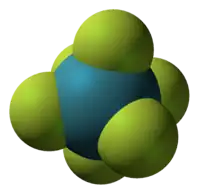Xenon hexafluoride
Xenon hexafluoride is a noble gas compound with the formula XeF6. It is one of the three binary fluorides of xenon that have been studied experimentally, the other two being XeF2 and XeF4. All known are exergonic and stable at normal temperatures. XeF6 is the strongest fluorinating agent of the series. It is a colorless solid that readily sublimes into intensely yellow vapors.
| |||
| Identifiers | |||
|---|---|---|---|
3D model (JSmol) |
|||
| ChemSpider | |||
PubChem CID |
|||
| UNII | |||
CompTox Dashboard (EPA) |
|||
| |||
| |||
| Properties | |||
| XeF6 | |||
| Molar mass | 245.28 g mol−1 | ||
| Density | 3.56 g cm−3 | ||
| Melting point | 49.25 °C (120.65 °F; 322.40 K) | ||
| Boiling point | 75.6 °C (168.1 °F; 348.8 K) | ||
| reacts | |||
| Thermochemistry | |||
Std enthalpy of formation (ΔfH⦵298) |
−294 kJ·mol−1[1] | ||
| Related compounds | |||
Related compounds |
Krypton hexafluoride | ||
Except where otherwise noted, data are given for materials in their standard state (at 25 °C [77 °F], 100 kPa).
Infobox references | |||
Preparation
Xenon hexafluoride can be prepared by heating of XeF2 at about 300 °C under 6 MPa (60 atmospheres) of fluorine. With NiF
2 as catalyst, however, this reaction can proceed at 120 °C even in xenon-fluorine molar ratios as low as 1:5.[2][3]
Structure
The structure of XeF6 required several years to establish in contrast to the cases of XeF
2 and XeF
4. In the gas phase the compound is monomeric. VSEPR theory predicts that due to the presence of six fluoride ligands and one lone pair of electrons the structure lacks perfect octahedral symmetry, and indeed electron diffraction combined with high-level calculations indicate that the compound's point group is C3v. It is a fluxional molecule. Oh is only insignificantly higher, indicating that the minimum on the energy surface is very shallow.[4]
129Xe and 19F NMR spectroscopy indicates that in solution the compound assumes a tetrameric structure: four equivalent xenon atoms are arranged in a tetrahedron surrounded by a fluctuating array of 24 fluorine atoms that interchange positions in a "cogwheel mechanism".
Six polymorphs of XeF
6 are known.[5] including one that contains XeF+
5 ions with bridging F−
ions.[6]
Reactions
Hydrolysis
Xenon hexafluoride hydrolyzes, ultimately affording xenon trioxide:[7]
- XeF6 + H2O → XeOF4 + 2 HF
- XeOF4 + H2O → XeO2F2 + 2 HF
- XeO2F2 + H2O → XeO3 + 2 HF
- XeF6 + 3 H2O → XeO3 + 6 HF
XeF6 is a Lewis acid, binding one and two fluoride anions:
- XeF6 + F− → XeF−
7 - XeF−
7 + F− → XeF2−
8
Octafluoroxenates
Salts of the octafluoroxenate(VI) anion (XeF2−
8) are very stable, decomposing only above 400 °C.[8][9][10] This anion has been shown to have square antiprismatic geometry, based on single-crystal X-ray counter analysis of its nitrosonium salt, (NO)
2XeF
8.[11] The sodium and potassium salts are formed directly from sodium fluoride and potassium fluoride:[10]
- 2 NaF + XeF
6 → Na
2XeF
8 - 2 KF + XeF
6 → K
2XeF
8
These are thermally less stable than the caesium and rubidium salts, which are synthesized by first forming the heptafluoroxenate salts:
- CsF + XeF
6 → CsXeF
7 - RbF + XeF
6 → RbXeF
7
which are then pyrolysed at 50 °C and 20 °C, respectively, to form the yellow[12] octafluoroxenate salts:[8][9][10]
- 2 CsXeF
7 → Cs
2XeF
8 + XeF
6 - 2 RbXeF
7 → Rb
2XeF
8 + XeF
6
These salts are hydrolysed by water, yielding various products containing xenon and oxygen.[10]
The two other binary fluorides of xenon do not form such stable adducts with fluoride.
References
- Zumdahl, Steven S. (2009). Chemical Principles 6th Ed. Houghton Mifflin Company. p. A23. ISBN 978-0-618-94690-7.
- Melita Tramšek; Boris Žemva (December 5, 2006). "Synthesis, Properties and Chemistry of Xenon(II) Fluoride" (PDF). Acta Chim. Slov. 53 (2): 105–116. doi:10.1002/chin.200721209. Archived from the original (PDF) on May 12, 2013. Retrieved July 10, 2009.
- Chernic, C. L.; Malm, J. G. (2007). "Xenon Hexafluoride". Inorganic Syntheses. Inorganic Syntheses. Vol. VIII. pp. 258–260. doi:10.1002/9780470132395.ch68. ISBN 9780470132395.
- Seppelt, Konrad (June 1979). "Recent Developments in the Chemistry of Some Electronegative Elements". Accounts of Chemical Research. 12 (6): 211–216. doi:10.1021/ar50138a004.
- Hoyer, S.; Emmler, K.; Seppelt, T. (October 2006). "The structure of xenon hexafluoride in the solid state". Journal of Fluorine Chemistry. 127 (10): 1415–1422. doi:10.1016/j.jfluchem.2006.04.014. ISSN 0022-1139.
- James E. House (2008). Inorganic Chemistry. Academic Press. p. 569. ISBN 978-0-12-356786-4.
- Appelman, E. H.; J. G. Malm (June 1964). "Hydrolysis of Xenon Hexafluoride and the Aqueous Solution Chemistry of Xenon". Journal of the American Chemical Society. 86 (11): 2141–2148. doi:10.1021/ja01065a009.
- Holleman, A. F.; Wiberg, E. (2001). Inorganic Chemistry. San Diego: Academic Press. ISBN 0-12-352651-5.
- Riedel, Erwin; Janiak, Christoph (2007). Anorganische Chemie (7th ed.). Walter de Gruyter. p. 393. ISBN 978-3-11-018903-2.
- Chandra, Sulekh (2004). Comprehensive Inorganic Chemistry. New Age International. p. 308. ISBN 81-224-1512-1.
- Peterson, W.; Holloway, H.; Coyle, A.; Williams, M. (September 1971). "Antiprismatic Coordination about Xenon: the Structure of Nitrosonium Octafluoroxenate(VI)". Science. 173 (4003): 1238–1239. Bibcode:1971Sci...173.1238P. doi:10.1126/science.173.4003.1238. ISSN 0036-8075. PMID 17775218. S2CID 22384146.
- "Xenon". Encyclopædia Britannica. Encyclopædia Britannica Inc. 1995.
- Cotton (2007). Advanced Inorganic Chemistry (6th ed.). Wiley-India. p. 591. ISBN 978-81-265-1338-3.

